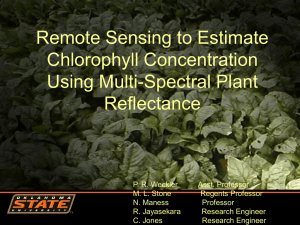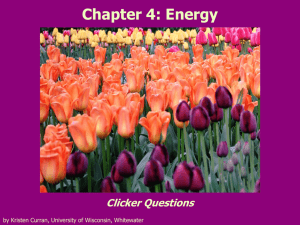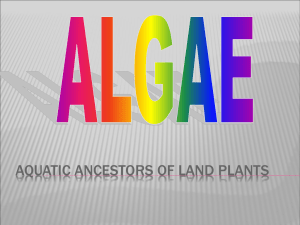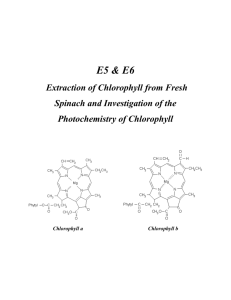04chlconc_presentation - Biosystems and Agricultural Engineering
advertisement
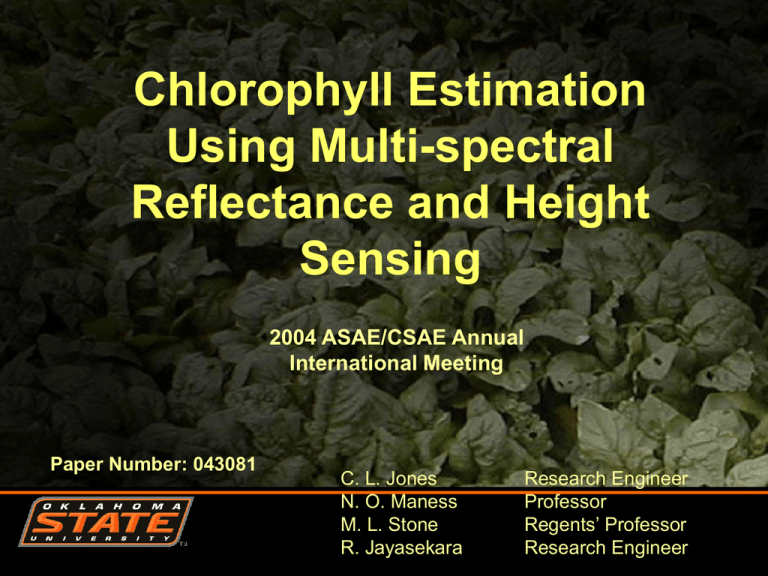
Chlorophyll Estimation Using Multi-spectral Reflectance and Height Sensing 2004 ASAE/CSAE Annual International Meeting Paper Number: 043081 C. L. Jones N. O. Maness M. L. Stone R. Jayasekara Research Engineer Professor Regents’ Professor Research Engineer Objectives • Select “best” wavelength or indices for estimating chlorophyll content and concentration in spinach • Non-destructively quantify chlorophyll content and concentration by combining biomass estimates with multi-spectral imaging system reflectance data. • Assess the feasibility of reflectance-based sensing in estimating chlorophyll concentration in spinach Paper Number: 043081 Let’s Talk Chlorophyll… (Content vs. Concentration) • Content: related to nitrogen concentration in green vegetation • Chlorophyll mass per unit ground surface area or per plant (mg/ha or mg/plant) • Indicator of photosynthetic capacity: productivity of the plant canopy Paper Number: 043081 Let’s Talk Chlorophyll… (Content vs. Concentration) • Concentration: estimate of pigment concentration – chlorophyll a and b • Chlorophyll mass per unit mass of plant material (mg/kg) • Indicator of plant physiological status: level of stress Paper Number: 043081 Previous Work No single spectral approach offers an adequate method of estimating pigment (chlorophyll) concentration in all plants. Paper Number: 043081 Experimental Plan • Consider spinach plants at the single plant level • Use chlorophyll content estimates to determine chlorophyll concentration (implies a need for biomass estimate) • Ccontent (mg) = Cconcentration (mg/kg) x biomass (kg) • Use ultrasound and digital imagery for biomass estimate Paper Number: 043081 Experimental Plan Estimators used for chlorophyll content investigation: – Rgreen : Reflectance at 550 nm ±10 nm – Rred : Reflectance at 670 nm ±10 nm – RNIR : Reflectance at 780 nm ±10 nm – NIR/RED : Ratio of reflectance at 780 and 670 nm ±10 nm – NIR/GREEN : Ratio of reflectance at 780 and 550 ±10 nm – NDVI670 = (R780 – R670)/(R780 + R670) – NDVI550 = (R780 – R550)/(R780 + R550) Paper Number: 043081 Plant Samples Two flats- no fertilizer Two flats adequate fertilizer Two flats 2x adequate fertilizer amount Provided varying biomass and chlorophyll levels Sampled at six weeks post plant Paper Number: 043081 Data Gathering Overview • Plants removed from flats • Individually placed on turntable (0.91 m diameter) 1.04 m below ultrasonic distance sensor (UDS) for height estimation • Turntable rotating at 1.06 rpm Paper Number: 043081 Data Gathering Overview • Plants placed under multispectral camera mounted on tripod for reflectance data and top view surface area estimate • Vegetative portion harvested, weighed, and packed on ice for transport to lab • Chlorophyll analysis per Inskeep and Bloom (1985) Paper Number: 043081 Ultrasonic Distance Sensor (UDS) Senix™ Ultra-SPA. (Senix, Bristol, Virginia) • 50 kHz, piezoelectric • 12 degree angle view, signal > 3db • Accuracy: better than 1% of target distance • Laptop computer • SoftSpan© software Paper Number: 043081 UDS Response Spinach Height Profile - Ultrasound 18 Height,cm 16 14 12 10 8 6 4 2 0 1.37 2.74 4.11 5.49 6.86 8.23 9.6 11 12.3 13.7 15.1 16.5 17.8 19.2 Range, cm Paper Number: 043081 Multispectral Camera • • • • • • DuncanTech MS3100 550, 670, 780 nm ±10 nm FWHM Resolution: 1392 x 1040 x 3 sensors Pixel size: 4.65 x 4.65 microns 14mm focal length lens RS232 interface with National Instrument’s PCI-1424 frame grabber • Dolch ruggedized laptop Paper Number: 043081 Multispectral Camera • Mounted on tripod 1 m above target • Target illuminated with incandescent lighting • Labsphere Reflectance Calibration Standard targets: 10%, 50%, 75%, and 99% (Weckler, et al. 2002) Paper Number: 043081 Multispectral Camera • Images processed with Matlab© • NIR, green, and red reflectance pixel values identified ρNIR - ρGreen or Red NDVI = ρNIR + ρGreen or Red • > 0 : plant material, < 0 : background, nonplant material, NDVI averaged • Image binarized • “bwarea” command to calculate vegetation area Paper Number: 043081 Biomass Estimation WEST = AMS x HUDS Where: WEST = estimated plant biomass AMS = surface area estimate from camera (pixels) HUDS = estimated plant height from UDS (cm) PWC = 0.86 Paper Number: 043081 Biomass Estimation W = 3E-05WEST + 2.0958 r 2 = 0.884 Actual Biomass (W), g 35 30 25 20 15 10 5 0 0.00E+00 2.00E+05 4.00E+05 6.00E+05 8.00E+05 1.00E+06 1.20E+06 Estimated Biomass (WEST), H UDS * AMS PWC = 0.86 Paper Number: 043081 Chlorophyll Content Estimation, r2 Chl. Content, mg/plant 300 C = 1364.5NDVI - 370.41 0.75 Ccontentr2 =vs. CONT Estimator estimator 0.21 250 200 Rgreen 150 Rred 0.10 100 RNIR 0.58 NIR/RED 0.15 NIR/GREEN 0.05 50 0 NDVI670 0 NDVI550 0.1 0.2 0.3 0.75 0.4 0.5 NDVI 0.40 Paper Number: 043081 Chlorophyll Content Estimation, r2 Estimator Ccontent vs. Ccontent vs. = 17.478(NDVI)(W ) + 22.82 CCONT(Estimate) estimatorr2 = 0.910 ESTestimator * WEST 0.21 0.87 350 Rred Chl. Content, mg/plant Rgreen 300 0.10 0.86 0.58 0.90 NIR/RED 100 0.15 0.90 50 NIR/GREEN 0.05 0.89 RNIR 250 200 150 NDVI670 NDVI550 0 0.00 2.00 4.00 0.75 8.00 6.00 NDVI*WEST 0.40 10.00 12.00 0.91 14.00 16.00 0.89 Paper Number: 043081 Chlorophyll Concentration Estimation •Estimated chlorophyll content calculated from regression equations for each band or ratio •CCONC = CCONT / WEST •Compared to actual Chlorophyll concentration Paper Number: 043081 Chlorophyll Concentration Estimation, r2 Estimator Ccontent vs. estimator Ccontent vs. estimator * WEST Actual Cconc vs. Cconc estimate Rgreen 0.21 0.87 0.22 Rred 0.10 0.86 0.30 RNIR 0.58 0.90 0.05 NIR/RED 0.15 0.90 0.04 NIR/GREEN 0.05 0.89 0.03 NDVI670 0.75 0.91 0.08 NDVI550 0.40 0.89 0.000004 Paper Number: 043081 Conclusions • Of the indices tested in this study, NDVI670 multiplied by estimated biomass appears to provide best estimate of chlorophyll content in spinach • Multiplying reflectance ratios and indices by estimated biomass improved chlorophyll content estimations • Reflectance-based remote sensing may not be the best method for estimating plant pigment concentrations (chl. a and b): RRED best, r2 = 0.30 Paper Number: 043081 QUESTIONS? Acknowledgments Support through funding from the USDA Special Research Grant Number 2003-06134 Paper Number: 043081
